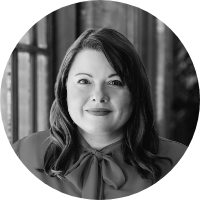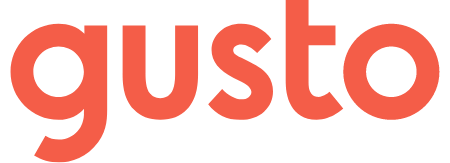Experience design is core to Gusto’s customer service — and its approach to teamwork.
Gusto builds user-friendly HR and payroll software for small businesses, but its success is driven from within.
The company’s experience design team is bringing customer-centered UX design principles in-house to architect individualized work experiences for all.
In this episode, we hear from Gusto’s Amy Thibodeau, chief design officer, and Liberty Planck, head of remote experience + how we work, about how these intentional and thoughtful design tactics are creating efficiencies, more opportunities for collaboration, and a stronger team culture.
As the champion of teamwork, Adobe is changing the world through digital experiences. Empower your team to do its best work through Adobe solutions — learn how in the webinars below.
Show notes
The Power of Teamwork is brought to you by Adobe and hosted by Garrett Schwartz.
Disclaimer: The views and opinions expressed by guests are their own and their appearance on this podcast does not imply an endorsement of them or any entity they represent.
Experience design is core to Gusto’s customer service — and its approach to teamwork.
Gusto builds user-friendly HR and payroll software for small businesses, but its success is driven from within.
The company’s experience design team is bringing customer-centered UX design principles in-house to architect individualized work experiences for all.
In this episode, we hear from Gusto’s Amy Thibodeau, chief design officer, and Liberty Planck, head of remote experience + how we work, about how these intentional and thoughtful design tactics are creating efficiencies, more opportunities for collaboration, and a stronger team culture.
As the champion of teamwork, Adobe is changing the world through digital experiences. Empower your team to do its best work through Adobe solutions — learn how in the webinars below.
Show notes
The Power of Teamwork is brought to you by Adobe and hosted by Garrett Schwartz.
Disclaimer: The views and opinions expressed by guests are their own and their appearance on this podcast does not imply an endorsement of them or any entity they represent.
The Power of Teamwork Season 1, Episode 5
“Strengthening Culture with Personalized Work Experiences” — Gusto
Host: Garrett Schwartz, Product Marketing Manager, Adobe
Guests: Amy Thibodeau, Chief Design Officer; Liberty Planck, Head of Remote Experience + How We Work
Transcript
Garrett Schwartz
In our always-changing work world, how does great teamwork happen? Intentional design is key. The Gusto platform takes the headache out of payroll processing. They do it by designing great teams who can better serve their customers. By applying the principles of experienced design, the leadership team at Gusto can figure out what their workers need to feel connected in remote and hybrid locations.
The result is successful teamwork.
Amy Thibodeau
What is the experience that will make people feel connected? Will feel a sense of belonging will entice them to engage in the experience, and then making sure there’s a really wide variety of what those things might be.
Garrett Schwartz
In this episode, I talk with Amy Thibodeau, chief design officer, and Liberty Plank, head of remote experience and how we work. Amy and Liberty use design thinking to create custom work streams for Gusto’s in-person and remote teams. From what they’ve seen, happier teams collaborate better.
Amy, let’s start with you. What’s your role, and what does your team do?
Amy Thibodeau
I am Amy and I’m Gusto’s chief design officer. I lead the designers, the researchers, the writers. I lead design systems, engineers, all the people who are working together to build a great product experience for our customers. And I do that remotely from Toronto, Canada.
Liberty Planck
I’m Liberty. I lead efforts around how we work as a company as well as the community team. A lot of the work I focus on is how we set up the company in a way that is leading to an optimal employee experience, and that’s unlocking them to do their best work so that we can better serve our customers. Part of that is things like infrastructure, what tools are we using, and it’s also this feeling of community and connection and belonging. Do we feel connected to the company, to each other, to our teams? So that’s really my focus.
Garrett Schwartz
And this is a new role. Was there any kind of challenge that Gusto was facing that they said, “Look, we need someone like Liberty and here to bring the teams together?”
Liberty Planck
Yeah, I think that hiring someone with an MBA in design is an unusual “people team” hire historically, and so having never worked in a people team or it was really empowering to have that philosophy going into it that they knew that they needed that and wanted to bring that lens.
Garrett Schwartz
Amy and Liberty, you both come from design backgrounds — Amy, more from the product side, right? And Liberty, your design is more around experiences. For someone like me that doesn’t come from a design background, what is design thinking?
Amy Thibodeau
So I have a spicy take on this question. I don’t really talk about design thinking or really believe that much in design thinking. What I believe in is “customer-centered thinking.” People outside of design, they do it, but they don’t really relate to the language. And so it can kind of keep them out. I believe in customer-first thinking, and I think that’s the way that I talk to my team and how I encourage them to think.
It still looks very similar to what is traditionally called design thinking.
Liberty Planck
I use it to solve ambiguous problems, but I don’t necessarily call it that. It’s my secret toolkit that I bring to any situation, big or small, that helps bring empathy, that helps bring perspective, that helps make it expansive so that people don’t feel boxed out.
I love what Amy said about making sure it feels like an inclusive experience because it is very intimidating, even as a design thinker, sometimes feeling like I’m not a creative or a designer.
And the reality is we’re all creative as humans. And so how do we remove some of this language or barriers to keep people from feeling like they don’t have the right to participate in that?
Amy Thibodeau
So we’ll do these sprints or these ideation sessions, and almost every person who comes to those initially who is not does not identify as a designer leads with that and says, “Oh, I’m not a designer. You know, don’t judge me. I’m a little scared that I’m here.”
And so I think anything that you can do to remove those barriers and those ways that I think we can sometimes unintentionally make people feel intimidated by process, which is really just around thinking bigger, you know, using good information, good data, good customer insights, where you have them to think bigger about a problem together. That’s really what we’re talking about.
Garrett Schwartz
Do you guys use teamwork to accomplish a common goal together?
Liberty Planck
Amy and I work really closely together on bringing our different perspectives. Amy’s been a really good partner for me on some of the programs, like she’s been an executive sponsor for this program called Brilliant Minds, where we’re trying to upskill remote workers as we both are passionate about how we enable people to be more effective.
And so I think we’ve been able to partner in certain initiatives across the company where we both have that common desire to see people succeed in this really specific area and also on workflow management. We’ve been working a lot on that lately.
The thing that ties us together is our passion for solving those problems, but then also the unique perspectives we bring to help solve those problems for how we design it within the company because it has to do both. That’s the beauty of service design. Its intention is to build systems that are not only for our employees, but allow our employees to better serve our customers.
So I think that’s how the partnership has been really powerful, is sort of seeing it manifest in these different projects.
Amy Thibodeau
Yeah, absolutely. I believe so deeply in Liberty’s work, and I think the fact that she approaches it as somebody who comes from a design background with that service design lens I think is really inspiring to me. And I think there’s also a natural feedback loop between how we build the culture and the company internally and how we build the product.
Garrett Schwartz
How does your hybrid model impact teamwork at Gusto?
Liberty Planck
Before the pandemic, we were primarily an office company, and obviously during the pandemic we went fully remote and Gusto made the decision to be hybrid. And they knew that that would have unique complexities. And so they wanted to hire someone that would focus specifically on that experience.
Garrett Schwartz
How many employees work at Gusto? Where are they located? Is there a central office? How many people do you have working remotely? What does that look like?
Amy Thibodeau
The design team is around 60 people. We are mostly remote. We do have some “Gustees” on the design team who are based near our physical hubs and who work in a hybrid way. So they will go into the offices certain days a week to collaborate with their teams. But the majority of my team is remote and I’m remote as well as a senior leader in the company.
We’re always looking for ways of identifying like when’s the right time to get together? What are the sort of moments that are important to gather?
And then what are some creative ways that we can create some creative moments? I like to think of it as manufacturing serendipity, creating these moments where people can connect about stuff that is not just about work? Because creative work really relies on psychological safety and a feeling of connection.
People don’t want to get wild and creative with their ideas in a room full of people that they don’t know whether it’s virtual or in real life. And so we’re always looking for rituals and mechanisms in ways that we can kind of manufacture that feeling of serendipity that you might have traditionally had in a physical office. You know, where you’re going to the coffee room and you run into somebody and they introduce themselves and you’re like, “Oh, you’re that person.” And you know, you start to talk about things, what you have in common, and then the next time you encounter that person over a project or something that has to be resolved, you know about them as people.
We don’t get that as easily, I think when we’re hybrid or when we’re remote. We’re always kind of looking for ways to sort of manufacture that, but also make it feel natural and fun for people rather than sort of a thing that they have to do, you know, an activity that they have to do over Zoom, which everybody is tired of.
Garrett Schwartz
Have you seen any boosts in productivity or collaboration with implementing some of those practices that you just talked about?
Amy Thibodeau
I think where we see improvements through that sense of connection is in the way that people feel, sort of their engagement, and I think their willingness to explore different ways of approaching problems together.
I think that’s not an easy thing to measure. We also see it in our employee sentiment. You know, my own team, I regularly get feedback from them as a team and I always enable ways for them to give that to me anonymously as well so that it’s a safe space for them to share things that they may not be happy about.
I think what we see is it’s super important for the people in the design team to feel a sense of connection to their cross-functional partners in particular. It’s easier to form a sense of connection with designers and other people who are doing creative work and maybe have similar frameworks and approaches to what you have. It can be a little harder to bridge those connections with people like engineers and product managers and data scientists. But those are the folks that they’re working the most closely with in their day to day.
Trying to find ways for them to build those connections as well. For example, we have a new product leader at Gusto and we’re inviting him in to do AMAs with the design team. I will spend time with the product team and we try to create these intentional moments for people to get together across disciplines because we work cross-disciplinary. We don’t just, you know, work with folks who do the exact same craft that we do.
Garrett Schwartz
I love that. And going back to what you said earlier about you might not have seen it like, “Oh, there’s Bob that I’ve been working with for a year. I finally met him in person.” There were so many examples when I was in the office, and the remote employees would come in. I’d be like, “Dude, I had no idea that you were 6’7”.
Liberty Planck
The height thing is such a funny one. Everyone always makes guesses on how tall or short someone is before meeting them in person.
Amy Thibodeau
Yeah, and also this weird experience. I don’t know if you all had this, but the first time that I actually went in to meet with people in person since the pandemic started, I had this weird moment where I was like, “I’m a person with arms and legs.”
I’m not just a head in a square, and it takes sort of a while to settle into that feeling again and to sort of be this like, fully embodied presence in a space and not just through a screen.
Garrett Schwartz
Totally. Amy, where did this idea of using design to create individualized work experience come from?
Amy Thibodeau
With Liberty joining and with the movement towards hybrid working, I think it’s just opened up more challenges along the same vein. You know, for us to really think about that service design piece as it moves between physical locations to the digital sort of experience that so many of us have today.
And I think a real challenge and I think Liberty would be the best one to speak to this actually is just, you know, how do we create experiences that are different because we are operating in different constructs. You know, I am at home in Toronto, in my home office. There are people who will go into a physical Gusto office. How do we sort of think about those experiences, not think that our job is to make them the same, but to make them equivalent so that everybody, regardless of where they’re working, is in a position where they feel that they have the opportunity to be connected, be supported, and to do work, that they’re really proud of.
I know this is sort of top of mind for Liberty to solve from a design perspective, just thinking across the spectrum of the ways people work at Gusto and all the ways that we want to support that.
Liberty Planck
Yeah, we care a lot about designing equity into our experiences and thinking about what is the infrastructure needed to help support that.
I think a lot of times it’s so easy to say, “We’re hybrid, and that means you need to do X, Y, Z.” But if you don’t actually build that into the way people work, it’s really hard to live it out. And so a lot of what I’m trying to do is think, okay, what is the experience the employee is having?
How do we set some of those norms to create a more equitable experience? How do we let people know it’s okay that it’s a different experience, and how can we make each of those experiences feel unique?
Rather than trying to put it into something that’s more collective, you can really design something that feels special and unique to them.
And the other part of it, too, I think, especially on teams, is it’s so easy to, especially during the pandemic, I think we got really into icebreaker as and all these different kinds of activities and games, and a lot of the feedback that I’ve given to different leaders and managers is really starting to figure out how to understand the different people on your team.
If there is someone that’s struggling to feel engaged or doesn’t show up to any of the team-building things, have you asked them what they might be into? Maybe they’re really into something that’s different and if you focus an activity on that, then it might pull them in and make them feel more connected and feel safer within the team.
Just kind of really using that for me, experience design around what is the experience that will make people feel connection, will feel a sense of belonging, will entice them to engage in the experience, and then making sure there’s a really wide variety of what those things might be.
Empathy is a huge pillar for me. It’s a muscle I had built throughout my career. Even before I even knew I was doing experience design, I was always thinking about what is the user experience and what’s that experience like?
I think on my team especially, it’s been really fun to expand their thinking about what empathy means. I actually have started leading them through some different design exercises around, “Hey, I’d love you to understand some pain points of what people are dealing with in the office or dealing with remotely,” and I think it’s really important to even do a lot of feedback loops.
We do a lot of surveys on the community team, but also companywide twice a year. To get input from “Gustees” is to really understand what the experience is for them because it’s so hard, even as a leader, to think outside of myself and to think outside of my experience.
I think empathy is really critical to making sure we really understand why we’re designing the solutions that we’re designing.
Garrett Schwartz
Recently, Gusto had a series of companywide workshops to figure out how to work better together. They called it this.
Liberty Planck
The exploring hybrid design sprint.
Garrett Schwartz
And how did you and Amy, your teams work together or collaborate on that project? What did that look like?
Liberty Planck
I worked really closely with Jadine on Amy’s team, who’s the head of design ops, and she was a key partner for us, especially even mapping out what’s the best way to do a design sprint. It was a really fun opportunity to work collaboratively. We set up a bunch of different cross-functional workshops with leaders, with people throughout the company from different levels and tenures and backgrounds.
And I think just having that partnership to think through how do we make sure we had partners from a lot of other teams too, from the IT team and representatives from across the entire company to make sure that even in those design thinking workshops, we are representing a very wide population of Gusto while we were trying to tackle some of these problems.
Amy Thibodeau
I think the way that Liberty also set these sessions up, which was really great, is they were small groups of people. I think you started by creating pretty sort of broad feedback and then bringing together small groups of people, creating a space where people could think pretty big and brainstorm together around some specific prompts and then, you know, turning those into themes and some action items.
One example is I am somebody who comes from a content design background originally. I do a lot of work with the design team to make sure we’ve got pretty robust documentation for our team. One of the pieces of feedback that we heard from some people was, “Hey, I just don’t know where to find things, you know, I don’t know some things in Google Docs or if it’s over here, over there. One of the ways you could really help me is just to help me know what the source of truth is.”
That was something that bubbled up, I think, in the session that I was in, that has opened up our ability to just get more people involved in thinking through problems, especially in the understanding phase of a project.
Garrett Schwartz
Liberty, is that something in your role too is looking at the standardization of collaboration tools inside the workplace?
Liberty Planck
Very much so. That’s one of the big things I’m working on right now, and I think actually one of the things Amy and I have been involved on projects together around is just thinking about not only workflow management and collaboration, but also tool redundancies. I think from the research I’ve done, it’s happened to many, many companies where during the pandemic we just started using tons and tons of tools.
And I think what we’ve realized now, looking back on it, is that it actually creates so many more silos and makes it really hard to work.
And I think what we’re really trying to figure out is what are the right tools? How do we set a standard for it? This is how we use this tool at Gusto, build it into onboarding so that you’re ready to go right away and that you have an understanding not only of how we use the tool at Gusto, but how your team uses the tool.
We did a survey around project management tools where we had a handful of them, and the feedback that people gave was “Please just pick one. I don’t want to have to, you know, if I work with this team, I have to use this one if I work with this team. So I’m using four different tools. They don’t talk to each other or they don’t integrate well, and I don’t feel like I’m confidently using any of them.”
I think what we really want to do is build up people’s confidence in their ability to be effective at their job and to collaborate with each other and reduce some of those silos.
Amy Thibodeau
We also don’t want people to be in meetings all the time, right? Like we really want to optimize for, build our time and give people expansive amounts of space to go deep into solving the problems that they’re uniquely positioned to solve.
Sometimes being face-to-face in person is the right tool, but it’s not always the right tool. And so I think by being really intentional about the tooling that we use, making sure that tooling is accessible and leads to great cross-functional collaboration, what that also does is it opens up more space for people to build and do creative work and focus on getting stuff done.
Garrett Schwartz
Amy, do you have guiding principles that you look to in leading the design team? And if you do, have they helped you evolve or even improve your teamwork or your team’s collaboration?
Amy Thibodeau
Yeah, so we have experience principles as a company that help guide the way that we think about building experiences. I also have themes that I talk to my team about. One of them is that “clarity is kindness.” We can debate, and we can disagree, and we can give one another constructive feedback, and we can still be kind and collegial and caring. That sounds obvious, but it is a muscle that needs to be worked.
Garrett Schwartz
I’m hearing a lot of inclusivity coming from this ideology. Is that something that you saw in the employee surveys, Liberty, that “Oh, I feel like I can be a part of this, that a boost team worked at a boost collaboration,” anything like that?
Liberty Planck
I think it’s in our fiber as a company. It’s in a lot of our principles. I think we hire people that are drawn to that mentality. I think there’s always room for improvement. I think there’s unique challenges with being hybrid that we’re still trying to figure out. I think no one has solved them. I think everybody is designing the map in real time and forging this new frontier of what it looks like to be distributed.
We’ve heard a lot of feedback around that, and I think we’re really trying to discern what is the optimal experience, not only for our business but also our employees, so that we can better serve our customers because there has to be a balance. I think it’s really easy to want to take everything employees say and say we have to design exactly for that, but we also have to think about the business.
And does that set us up to best serve our customers? So that’s always the scale that we’re trying to balance.
Amy Thibodeau
And fundamentally, that’s when people are most excited and engaged, right? Like when they’re working together to build something that they believe in.
Garrett Schwartz
What’s something you’ve learned about yourself working on a team?
Liberty Planck
Something I’ve learned about myself. Working on a team is the need to make sure I’ve left the team at the end of the meeting with clarity. I have a lot of things going on in my mind all the time, and so making sure that they have what they need to be successful at the end of that, instead of assuming that they’ve under said, I love to repeat things back and make sure, hey, do you have everything you need to get this to the next stage.
Amy Thibodeau
I think the importance of getting comfortable with silence even in a Zoom-first world, my natural inclination is to fill silences with words. And I literally have a sticky note on my computer with the words “WAIT,” which stands for “Why am I talking?” So I’m really trying to get comfortable with silence and space because when I do that, other people always fill it with something interesting that I would not have thought of.
And I lose that opportunity when I am uncomfortable with silence and try to fill the silences with talking.
Liberty Planck
I love that. I think I want to steal that post and make one for myself.
Garrett Schwartz
Definitely doing that too.
To learn more about the ways Gusto uses design thinking to power their people, check gusto.com, and you can follow Amy and Liberty on LinkedIn.













